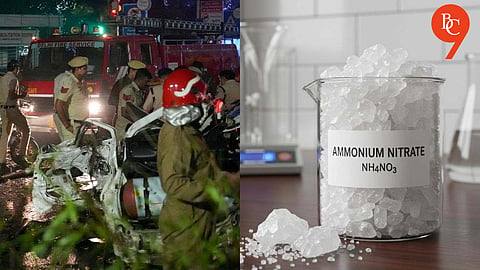

Initial investigations into the explosion that devastated a slow-moving vehicle near Delhi's Red Fort, resulting in the deaths of at least nine individuals and injuring several others, indicate it was triggered by a combination of ammonium nitrate, fuel oil, and other explosives. The incident took place just hours after authorities discovered approximately 360 kg of suspected ammonium nitrate along with a stockpile of weapons and ammunition at a rented property belonging to a Kashmiri doctor in Faridabad, adjacent to Delhi.
According to the police, the explosion happened in a car with three people inside, and they are investigating whether it was a suicide bombing. 'The explosion took place in a moving Hyundai i20 with three occupants. We haven't discovered any pellets or puncture wounds on the injured, which is uncommon in such blasts. We are examining all possibilities,' stated a senior police officer.
In basic terms, it is a salt composed of one ammonium ion and one nitrate ion, created through the reaction of ammonia (NH3) with nitric acid (HNO3), resulting in the formula NH4NO3. Its high ammonium and nitrate content make it an efficient and commonly used fertilizer. Being a salt, it is water-soluble, which makes it ideal for use in irrigation systems.
A significant portion of the global food supply continues to depend on nitrate-based fertilizers. However, ammonium nitrate also acts as an oxidizer, providing oxygen to fuel combustion. There are two scenarios in which ammonium nitrate can explode. The first occurs when it is exposed to fire or comes into contact with a flammable material during a blaze. A devastating instance of this was the explosion in Beirut, Lebanon, in August 2020, where a fire triggered the detonation of 3,000 tons of ammonium nitrate, resulting in over 200 fatalities and more than 6,000 injuries.
Lebanese authorities reported that the material had been kept in a port warehouse for more than six years. It can also explode when combined with an explosive material, turning into a low-cost bomb capable of causing extensive harm. This form is known as ANFO, or ammonium nitrate fuel oil, and is utilized in controlled environments across different sectors, including construction and mining.
Ammonium nitrate can indeed be combined with nearly any type of volatile material. However, the quality is crucial because pure NH4NO3 is both chemically and thermally stable, necessitating an external detonation. A more powerful initial detonation is likely to produce a larger and more stable explosion.
However, when detonation occurs, the flammable nature of ammonium nitrate becomes dominant. It's crucial to understand that NH4NO3 is not inherently explosive. When stored properly and kept away from extreme heat, it is quite challenging to ignite. Nevertheless, improper storage can cause it to degrade quickly, which has been the cause of industrial accidents, such as the one in Beirut.
Is sale of ammonium nitrate regulated in India?
Indeed, according to regulations established in 2012 under the Explosives Act of 1884, any mixture containing over 45 percent ammonium nitrate by weight, including emulsions, suspensions, melts, or gels (with or without inorganic nitrates), is classified as an explosive.
To produce and manage the chemical, licenses are necessary, and there are regulations governing its storage, transportation, and sale. These regulations include limitations on storing it in densely populated regions. Additionally, the import and export of ammonium nitrate are strictly regulated.
